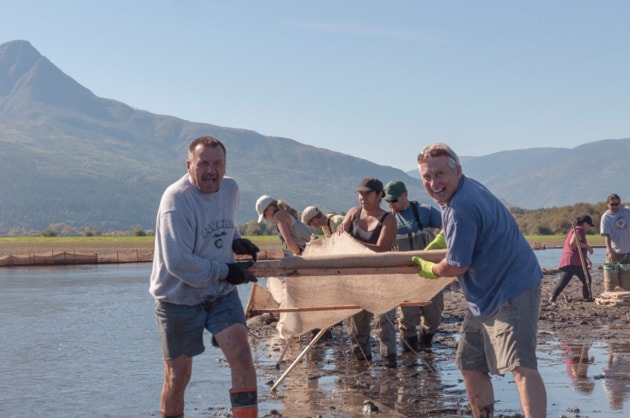Volunteers gathered to try to make chinook and coho salmon’s journey through the Salmon River Delta to their spawning grounds easier.
Water in the Delta is only a few inches deep making passage for the fish, especially the large chinook salmon, difficult.
“The biggest concern is habitat. It’s not so much controlling harvesting as it is about preserving the habitat,” said Rick Simpson co-chair of the fisheries committee for BCWF Region 8.
Approximately 20 volunteers and employees of various government agencies gathered Sept. 14 to deepen and widen a channel within the delta, to allow the salmon safe passage up the river. The volunteers used, shovels, sandbags and biodegradable burlap fences to construct the channel.
Members of the local fish and game club, the Ministry of Forests Lands and Natural Resources, the Department of Fisheries and Oceans, the BC Wildlife Federation (BCWF) and the Neskonlith Indian Band participated in the stream consolidation.
A group came out Sept. 3 to consolidate the channel, but part of their work was lost to erosion and had to be rebuilt.
Sarah Ostoforoff, a resource restoration biologist with the Department of Fisheries and Oceans directed the creation of the new channel.
Wednesday’s (Sept. 14) efforts were one of the last chances they had to help the chinook run, Ostoforoff said.
The coho salmon have an easier time negotiating the delta because they are smaller and swim the channel later in the fall when the water is higher.
Bonnie Thomas, a Neskonlith band elder who was on hand to help with the channel restoration, said along with being an important part of the salmon migration, the delta is home to plants with a variety of traditional uses for the local First Nations.
The trees in the area are used for traditional tea and ropes and the bullrushes which once grew thick in the area, along with having traditional uses, held the banks of the channel together with their root system, Thomas said.
“My grandmother told me she could walk across this river on the backs of the salmon when she was young. It’s not like that anymore.”
The volunteers have been working to expand the channel for the last two years. Before that, it was untouched for 10 years, Ostoforoff said.
The delta water levels were lower in 2015.
“The nearby landowners have been super co-operative in working on drought management in the area,” Ostoforoff said, but added the water is still too low at the mouth of the river for the salmon to migrate without help.
A fishing ban remains in effect for the Salmon Arm Bay allowing the fish time to make their way into the river.
